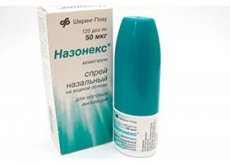Medical expert of the article
New publications
Preparations
Nazonex
Last reviewed: 03.07.2025

All iLive content is medically reviewed or fact checked to ensure as much factual accuracy as possible.
We have strict sourcing guidelines and only link to reputable media sites, academic research institutions and, whenever possible, medically peer reviewed studies. Note that the numbers in parentheses ([1], [2], etc.) are clickable links to these studies.
If you feel that any of our content is inaccurate, out-of-date, or otherwise questionable, please select it and press Ctrl + Enter.

Indications Nazonex
Indications for prescribing the drug include:
- prevention of exacerbation of seasonal allergic rhinitis (severe or moderate). It is recommended to start preventive procedures before the flowering period of plants that cause allergies begins (2-3 weeks);
- elimination of year-round or seasonal allergic rhinitis in children from 2 years of age, and also in adults;
- treatment of chronic sinusitis in the acute stage in adults (this category also includes elderly patients), and in addition to this, children 12+ years old. The spray can be used as an addition to the main treatment process.
Release form
It is produced as a nasal spray in plastic bottles with a volume of 18 g (enough for 120 doses). The package contains 1 bottle with a cap, and in addition, a spray nozzle.
Pharmacodynamics
The drug acts by slowing down the process of releasing inflammation conductors. Reduces the concentration of inflammatory exudate inside the inflammatory focus, preventing marginal accumulation of neutrophilic granulocytes (they participate in the process of creating an inflammatory reaction). As a result, the production of lymphokines decreases, and the process of macrophage movement slows down - as a result, the rate of granulation and infiltration processes is weakened.
In addition, the drug slows down the development of an immediate allergic response (reducing the rate of release of conductors (which provoke the inflammatory process and also suppress the synthesis of eicosatetraenoic acid) from mast cells).
Pharmacokinetics
In case of correct intranasal use of the drug, its bioavailability in the hematopoietic system is less than 0.1%. It should also be noted that even high-tech methods for determining substances in blood serum do not allow detecting Nasonex. Biotransformation of the active substance occurs in the liver.
Dosing and administration
To eliminate allergic rhinitis (year-round/seasonal), the dosage for children aged 12+, and adults together with them, is 2 sprays per nostril (once per day is enough - in total, per day, you will get about 200 mcg of medicine). If symptoms of improvement appear, the dose should be reduced to 100 mcg (1 spray per spray). A maximum of 400 mcg of medicine can be used per day (i.e. a maximum of 4 sprays per nostril).
For children aged 2-11 years, the dosage is 50 mcg per day (per nostril). Thus, in total, 100 mcg of the medicine is used per day.
The positive effect of using the spray begins to appear after 12 hours – noticeable signs of improvement in the condition appear.
To eliminate the symptoms of exacerbated chronic sinusitis, the medicine is used in the amount of 100 mcg twice a day (2 sprays on each nostril). In total, the daily dosage is 400 mcg. In this case, the daily maximum is 800 mcg - 4 sprays on each nostril twice a day. After achieving the desired effect, the dosage of the medicine should be reduced.
Before performing the procedure, you need to shake the spray bottle.
Use Nazonex during pregnancy
There has been no thorough testing regarding the use of the drug during pregnancy. In general, the drug has extremely low bioavailability when administered intranasally, but it is still better not to use Nasonex during lactation or pregnancy unless absolutely necessary.
It is necessary to carefully monitor the function of the adrenal glands in newborns whose mothers used Nasonex while pregnant - this is necessary to avoid the possible development of hypofunction.
Contraindications
Among the contraindications:
- children under 2 years of age;
- tuberculosis of the respiratory organs;
- untreated respiratory diseases (they can be viral, fungal or bacterial in nature);
- individual intolerance to the components of the drug;
- recent nasal surgery or injury.
 [ 8 ]
[ 8 ]
Side effects Nazonex
During the treatment of year-round or seasonal rhinitis of allergic origin, patients developed the following side effects: in adults - the development of pharyngitis, nosebleeds, severe irritation of the mucous membrane, and in addition, a burning sensation in the nose; in children, in addition to bleeding and irritation of the mucous membrane, sneezing and headaches were observed.
When using the spray as an additional drug during the treatment of exacerbated chronic sinusitis, similar reactions occurred. But it should be noted that in this case, nosebleeds developed extremely rarely, were mild, and passed on their own.
In isolated cases, treatment with Nasonex has caused an increase in IOP (intraocular pressure) and perforation of the nasal septum.
Interactions with other drugs
When Nasonex was combined with the drug Loratadine, no adverse reactions occurred. No interaction studies with other drugs were performed.
 [ 13 ]
[ 13 ]
Storage conditions
The medicine must be kept in standard conditions for all medications. Temperature conditions: 2-25 degrees.
 [ 14 ]
[ 14 ]
Shelf life
Nasonex is approved for use for 3 years from the date of manufacture of the spray.
Attention!
To simplify the perception of information, this instruction for use of the drug "Nazonex" translated and presented in a special form on the basis of the official instructions for medical use of the drug. Before use read the annotation that came directly to medicines.
Description provided for informational purposes and is not a guide to self-healing. The need for this drug, the purpose of the treatment regimen, methods and dose of the drug is determined solely by the attending physician. Self-medication is dangerous for your health.

